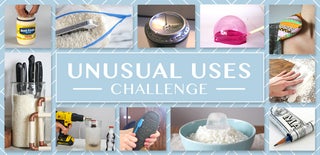Introduction: Turning a Cement Pen (no Lathe)
I was challenged to turn some pens without the use of the lathe -- a way to challenge myself because this is a pretty specialty tool that isn't in everyone's shop. A drill press however is a staple in any woodshop.
Turning pens made from cement, genius right? My original idea was just to pull the aggregate out of concrete and use that mixed with water for some pen blanks. You can see I wasn't very optimistic because I poured enough for 6 pens and none of them came through alive. Luckily I had poured some other blanks in anticipation of that which were a mix of cement and epoxy. The blanks were first shaped on the disk sander and then I mounted them in the drill press to finish shaping. The drill press was also used as a pen press to assemble the pen kit.
__________________
Notable Materials:
> Pen Kits
> Cement
> Beeswax & Mineral Oil Finish
Notable Tools:
> Bandsaw
Step 1: Cutting the Form
I start with a chunk of 4x4 framing lumber to use as a form. This piece is cut in half to assist with the removal of the cement after it cures.
The two pieces are then temporarily attached together with a few screws.
I use a forstner bit to drill out holes along the length of the wood form which will create cylindrical pours to make the pen from.
This piece of hardboard is used to cap the bottom of the form, it's fixed in place with a few screws.
Step 2: Pen Kits & Preparing the Tubes
That's a pile of pessimism/foresight right there. I got a bunch of pen kits because I wasn't super confident that the cement pen blanks would work out.
To help keep the tubes in place within the blanks I scratch the outside of them with sandpaper to roughen up the surface.
These are all stuck in place temporarily with hot glue. 12 tubes total which will give me 6 pens.
Step 3: Pouring Cement/Water Mixture
I mix up the cement with water and mix it until it looks like peanut butter.
This is poured into the forms super carefully to avoid getting it inside the tubes. Also, prior to pouring I spray inside the forms with polyurethane to help seal up the wood to keep it from pulling the water out of the mix.
All of them are poured and set to cure for a few days.
Once they look pretty solid, I pop the screws out of the form and pull the 2 halves apart.
I pull all of these out of the form and let them sit for another week before I try to turn them. In case I hadn't foreshadowed it enough, I then tried to turn them and all but one of them cracked on me...
Step 4: Pouring Cement/Epoxy Mixture
Attempt number 2! Instead of just a simple water/cement mixture I use epoxy and cement to give me a more solid mixture for turning and also something that will be more stable when it's so thin.
I'm a little more confident this time so I only pour 4 pen blanks to create 2 pens. These are set to cure for a couple of days.
These are a lot more difficult to remove from the form because the epoxy/cement mixture bonds with the wood so I cut them apart and cut as much wood off of them that's safe on the bandsaw.
To finish bringing these down to the cement I use a disk sander and carefully sand off the rest of the wood.
Step 5: Turning the Pen
This project was part of a challenge to make a pen without using a lathe so I decided to utilize my drill press instead, figuring just about every woodshop has one of these. I mount a steel shaft in the chuck and pad it out to size with some tape until it fits super snug within the tube.
Just a friction fit holds these in place while I turn them.
These actually shape down much easier than expected, no turning tools are needed. I just use some really rough sandpaper (80 grit?) to bring it down to a perfect cylinder and then start shaping it.
Sanding through the grits you can see it taking it's shape! I sand through to 220 grit until it's smooth.
Step 6: Finishing & Assembly
To finish these I use a homemade mix of beeswax and mineral oil. I rub it on and let it dry, then buff it off to a sli
I was actually able to get all of those 4 blanks turned down without any catastrophes. I use my drill press again as a pen press to push all of the pieces together into the tubes.
It's takes some careful pressure to not bend or scratch any of the pen part
After a couple weeks of these, it's finally a success.
Step 7: Glamour Shots
Be sure to check out the build video for the full experience!
-------------------------------------------------------------------------------------------------------
Thirsty for more? You can also find me in other places on the interwebs!
My Website: Essentially my entire life
YouTube: Me, in moving picture form
https://www.youtube.com/jackmanworks
Instagram: Preview my projects as they progress #nofilter
https://www.instagram.com/jackman_works
Twitter: Riveting thoughts, in very small doses
https://www.twitter.com/jackmanworks
-------------------------------------------------------------------------------------------------------
Note: This post contains affiliate links. Thank you for supporting what I do!

Runner Up in the
Unusual Uses Challenge 2017













